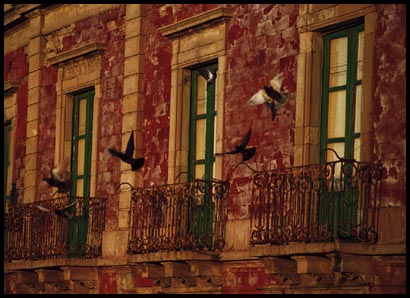An Italian experience: Photographs by Richard Lasner
by Claudia Rousseau
Nov. 19, 2003
 In "Lungomare I: Siracusa," the viewer can almost feel the rough surface of the stucco or the stones, smell the salt air or hear the pigeons' flapping wings. |
The photographs in "Italian Seductions," now on exhibit at the Creative Partners Gallery, are extraordinary for many reasons, not the least of which is their author's permeating sensibility. In speaking of them, Lasner will relate a personal experience with each. This deep connection with the subject in each image infuses the work with a character that moves away from the often objective stance of the photographer into the more subjective realm of painting.
I believe that Lasner would have liked to be a painter. The artist has done the next best thing. Using the camera as a tool, his finished prints are at least two steps away from the purely photographic act.
The process involves the transition from photograph to Iris print. An Iris print is the highest form of a process widely known as giclee, a word derived from the French verb meaning "to spray." Archival watercolor dyes are sprayed through the Iris printer's ink jets in micro-droplets at the rate of four million per second. As the drum holding the paper turns, the color is being applied in layers, much like a watercolorist paints. The resulting image has extraordinary resolution, with a very smooth tonal range and an intense saturation unlike any other printing technique.
After processing traditional 35 mm film into positives, Lasner scans them into the Iris printer. At this point, a master printer uses special color tables to match the colors of the positive with the dyes that will be used to create the prints on heavy textured paper. Lasner tries to use the whole frame directly from the negative, but while examining the proofs, he can make subjective changes to coloration or composition before approving the final digital file. The finished prints, literally glowing with the deep saturation and contrast the process provides, are large scale, measuring an average 20 by 30 inches. The size, the textured surface that picks up the watercolor dyes in very slightly varied relief, and the original photographic image's depth of field combine to make a visual experience that is complex but accessible to any viewer.
Lasner has created essays on various geographic areas of Italy in successive short trips during the past eight years; most of the work in this exhibit is from the past year. Perhaps the most interesting aspect of the selection is the way the pictures communicate so strong a sense of place without human presence. The absence of people in images of places so full of the traces of culture over centuries is a visual seduction. One is drawn into the place, alone, to wander through it vicariously. Some images are so dense with the sensuous aspect of the Italian experience that looking at them, you can almost feel the rough surface of the stucco or the stones, smell the salt air or hear the pigeons' wings flapping as they suddenly rise into the early morning light from an old Sicilian palazzo fašade -- as in "Lungomare I: Siracusa." This is an especially successful image, with its rich terra cotta color filling the whole field, accented by green shutters. The sense of the time of day is very significant in all these pictures, the changes in the weather and again, as in "Lungomare I," capturing that lucky moment with the light just breaking and the birds in sudden flight.
Among other prints I especially liked were "Galleria: Trevi," with its repeated groin vaults over an immaculate tiled floor, the insides of the arches of the front of the arcade illuminated by brilliant light reflected off windows of cars parked just beyond it (information provided by the artist). The perspective is typical of the deep spaces Lasner manages to photograph without losing the strong two-dimensional design value that also characterizes his work. A similar effect is achieved in a view into the empty courtyard of "Certosa San Lorenzo," a 12th century monastery in Tuscany.
"Clock Tower: Loro Ciuffenna" not only conveys the view of a cold morning in a hilltop town in the mountainous area of Pratomagno, but is also visually fascinating for its nearly vertical perspective and palette reminiscent of ancient Roman painting.
A high perspective view of three cliffs in heavy fog on the undeveloped part of the Amalfi coast ("Scogliera: Costa Amalfitana") approaches the appearance of watercolor with an almost Asian touch. This is a good example of how the colors can be controlled in the making of Iris prints; each cliff is a lighter, softer grey as the image moves back into space and up the picture plane. Another would be "Cipressi: San Quirico," featuring a neat rectangular cypress grove in the middle of an ocean-like field of green. Here the color was distinctly heightened and somewhat altered to emphasize the strange, almost surreal character of the image.
Lasner also has successfully experimented with works printed in black and white from an original color positive. In "La Finestra Rotonda: Spello (Umbria)," the white stucco exterior of a 15th century house, with an oculus window above a classic arched doorway, is seen in a strictly controlled spatial relation to the tree that frames the composition's right and upper edges. On that heavy textured paper, the surface of the stucco is nearly tactile. Deep blacks contrast sharply against bright whites, and delicate shadow effects in the foliage and in the upper right corner create an exceptionally striking image.
"Italian Seductions: Richard Lasner Photographs" is at Creative
Partners Gallery, 4600 East-West Highway, Bethesda, through Dec. 6. Hours
are Tuesday through Friday, noon to 6 p.m., and Saturday, 11 a.m. to 5
p.m. Call 301-951-9441.